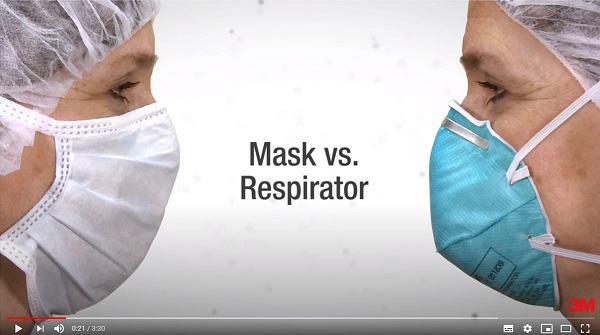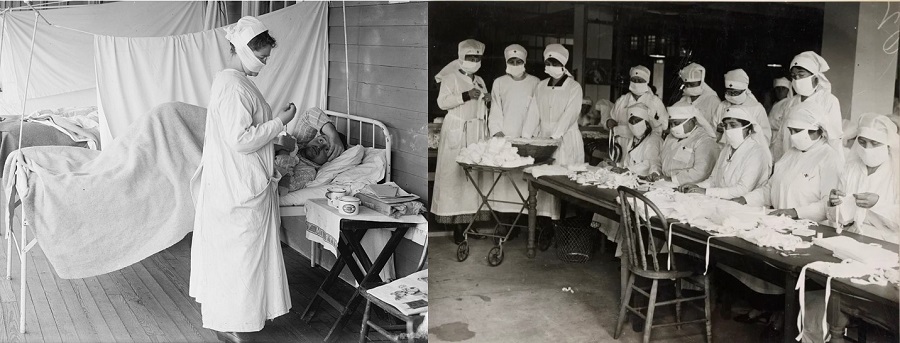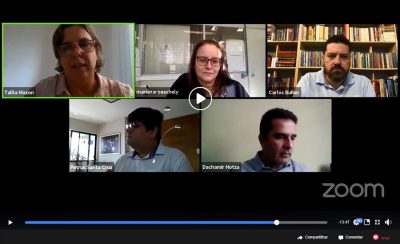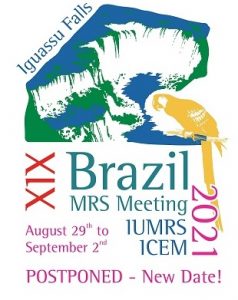Sorry, this entry is only available in Brazilian Portuguese.
Tag: covid-19
From Idea to Innovation: From gauze cloths to nonwoven respirators.
Since the official declaration of the Covid-19 pandemic on March 11, there has been much controversy about the use of masks, especially in the first months. However, one aspect has never been questioned: the masks that offer greater protection to the user should be worn by frontline workers of the fight against Covid-19, these men and women who perform essential work in the pandemic and are in daily contact with high concentrations of the Sars-Cov-2 virus in hospitals and cemeteries. Images of doctors, nurses and cemetery workers wearing masks and other PPE (personal protective equipment) have become icons of the pandemic currently affecting the world.
In fact, the masks best suited to protect these professionals are given the technical name of “respirators” (yes, the same term used for devices that help ICU patients to breathe and which have also been protagonists in this pandemic), seeing that their main objective is to filter the air breathed by the user, preventing a large part of the airborne particles (including viral particles) from entering the airways through the nose and mouth.
The respirators recommended for these professionals in the Covid-19 epidemic (certified as N95, KN95, PFF2 or DS2, depending on the country of certification) have high capacity to prevent the passage of particles. But that is not enough. In addition to being good at filtering, respirators need to ensure a minimum of comfort and good airflow so as not to suffocate the user throughout the workday. They also need to be firmly fastened to the head. Finally, they must ensure effective sealing around the mouth and nose to minimize the entry of unfiltered air into the airways of the worker using them. This set of features distinguishes respirators from other types of masks, including surgical masks.

To bring together these characteristics, N95 respirators include a series of developments and advances linked mainly to the materials used and the product design, as well as methods to prove their effectiveness.
Early days: the antiplague mask
The idea of filtering the air to protect people from pathogens that enter the body through the respiratory tract is not new, but it is also not that old. People wearing rigid masks or handkerchiefs to protect themselves from diseases were depicted in Renaissance paintings. However, this protection was associated with several beliefs with no scientific basis, and not with the idea that microorganisms can cause disease, a concept whose discovery dates back to the second half of the 19th century in Europe.
At the end of the 19th century, another step was taken in Europe with the scientific finding that droplets leaving the airways carry bacteria. Consequently, we have the first examples of surgeons using pieces of gauze tied to the head by strings to cover the mouth and nose during surgeries, in order to not contaminate patients.
In 1910, while the use of surgical masks was slowly spreading across Europe, the masks moved on from the operating rooms. More precisely, it was during the so-called “Manchurian plague” – an epidemic that occurred in northern China – that the first clear example of the use of masks is found with the aim of protecting the user, especially doctors, from an infectious disease. In this epidemic, a pathogen (probably a bacterium) caused pneumonia, which, according to the records of the time was lethal in almost all cases. The plague decimated some 60,000 people in less than a year.
It was initially believed that the disease was transmitted by rat fleas, but that idea fell when Dr. Wu Lien-teh was hired by the Chinese government to deal with the epidemic. After performing an autopsy, Wu obtained the necessary evidence to claim that the pathogen was transmitted through the air. Based on this observation, and based on the surgical mask concept he had seen in Europe, he developed a cotton filter mask wrapped in gauze that covered mouth and nose and several layers of cloth wrapped around the head and tied around the neck in order to guarantee that the mask was fastened and sealed the face. Wu called his invention an “antiplague mask” and tried to disseminate its use among those who cared for the sick, and, as far as possible, also among patients and the general population.

Other mask models appeared at this time in Manchuria, including a hood with eye holes, but Wu’s model seems to have been the one accepted. Apparently, the antiplague mask, with its several layers preventing the passage of droplets and its relatively high filtering capacity, reasonably protected the user from the pathogen. However, some people doubted its effectiveness and also the transmission of the disease through the air. Such was the case with a prominent French doctor who came to Manchuria to work on the epidemic. He denied using the mask, fell ill and died within a few days, according to Wu in his autobiography.
A few years later, in 1918, the use of masks spread throughout the world with the rapid spread of the deadly flu pandemic unjustly called the “Spanish flu”, which was caused by the H1N1 influenza virus and killed 50 to 100 million people in about two years. During this period, the masks, made of gauze and other cotton fabrics, became part of not only the uniforms of doctors and nurses, but also the uniforms of city policemen as well as the soldiers who were still fighting in the trenches at the end of the First World War. These masks were produced more professionally and extensively, with teams of Red Cross nurses cutting and sewing fabrics. In some cities, part of the population adopted this protective accessory, usually made at home. In other cities, its use was mandatory.

Meanwhile, in the early decades of the twentieth century, doctors were trying to determine which type of mask would be most efficient to protect the user from respiratory droplets carrying microorganisms, and some new models and patents emerged, but without major innovations. These masks were usually made of several layers of cotton gauze. Sometimes they included an additional layer of waterproof material and, in the most advanced models, a metal frame. All these masks were washed or sterilized and reused.
Respiratory protection for industrial workers
At the same time, researchers, companies and governments in countries like the United States were working on the development and regulation of respiratory protection for other workers: those in mining and construction, who were highly exposed to inhaling particles dangerous to their health. This problem was not new. Records from Ancient Rome, in the 1st century AD, show the use of animal skins to cover part of the face in order to filter out the presence of airborne toxic powders. However, in the 1930s, a tragedy forced the need to urgently implement this type of protection. Hundreds of workers died from lung problems caused by inhaling silica dust during the construction of a tunnel in the state of West Virginia, in the United States.
In the late 1950s, in the United States, a woman in her forties propelled the history of the development of respirators. Sara Finkelstein, with a degree in Design, but interested in multidisciplinary approaches, founded the Sara Little Design Consultancy, whose name alluded to her short stature (and her good humor). One of her first works was for 3M, in the company’s wrapping and fabrics division, where a new material for decorative tapes was being tested, the “nonwoven fabric”.
This group of materials is defined and understood through its opposite, the group of fabrics. While fabrics are obtained by weaving or knitting, non-woven fabrics are manufactured using other processes to connect the fibers together. One of the most common processes is meltblowing, in which a molten polymer is blown through a mold with very small orifices by a strong air blast, causing the random deposition of polymeric fibers and thus forming the nonwoven fabric. Another difference: fabrics are ordered structures of threads, usually arranged at right angles; nonwovens, on the other hand, are tangles of crude fibers. With a very porous structure, formed by very small pores and fibers intertwined in a disordered way, nonwoven fabrics are great filtering materials: they let gases pass, while solids are trapped in the fiber maze.
But back to Sara Little: aware of the impact materials innovation can generate not only in a company, but also in the lives of consumers of the final products, she made a presentation to 3M directors proposing the many possibilities for the application of nonwoven materials, recommending the development of a business area dedicated to these materials. At that time, the nonwoven industry was very new in the United States, as well as in Europe; it is estimated that the production of these materials on a pilot scale started in the 1930s.
Apparently, Sara Little designed, for 3M, some products using nonwoven fabric, starting with a bra cup. The idea and design of the first 3M respirator, with its semicircular shape resembling a bra, the clip to seal the mask over the nose and the elastics to fasten it to the head is mainly attributed to her. It is said that Sara’s intention was to create protection for hospital workers, whose routine she had known personally after many years of accompanying sick family members. However, at that moment there was no consensus regarding the health professionals’ need to use respirators, except for the use of masks during surgical procedures, which were mainly aimed at protecting patients from the doctors’ respiratory secretions and protecting doctors from blood and other patient fluids.
At 3M, the first respirator was launched in the early 1960s, with no official certification but with proof of its efficiency in filtering powders, which is so necessary to protect workers exposed to inhaling harmful particles in mining, construction and car painting activities, among others. In 1972, 3M was the first company to introduce a certified respirator to the market.
Respirators for doctors and nurses
Regarding the filtration of microorganisms, at that time there was no clear evidence, but some records show that these respirators, manufactured on an industrial scale, were sold to doctors and nurses who wanted to protect themselves. With the introduction of nonwoven materials replacing fabrics, disposable masks began to enter hospitals, a well received novelty at the time as it reduced costs related to washing and sterilization personnel and, at the same time, brought more sanitary security.
For about twenty years, with no major news of diseases transmitted by respiratory droplets or airborne, N95 respirators have spread and were recognized as respiratory protection equipment in the industry. However, in the 1990s, the use of this personal protective equipment increased in hospitals given the outbreaks of antibiotic-resistant tuberculosis that had infected many health professionals.
In the same decade, new technologies absorbed by the industry allowed to further improve the performance of respirators, especially with regard to the retention of smaller particles, such as viruses. With these processes, which have some patents, it was possible to generate an electrostatic charge in the fibers of the nonwoven material, which attracted the particles – somewhat similar to what happens when pieces of paper stick to a balloon that has been rubbed against a wool coat. Thanks to this strategy, the capacity of respirators to retain particles has increased without having to add new layers of filtering material, thus preserving the good air intake that respirators must provide.
One of the researchers involved in patents on processes for electrostatic charge of nonwoven materials has gained a lot of visibility recently. This is Peter Tsai, who made his contributions while professor at The University of Tennessee, in the United States. Tsai returned to scientific activity in March of this year shortly after retiring. As a specialist in the manufacturing and treatment processes of the nonwoven materials used in masks, Tsai has been working to help establish safe sterilization mechanisms for N95 respirators, given the scarcity of this product generated by the Covid-19 pandemic.
With all these advances in materials, technologies, concepts and methods, respirators have entered the 21st century ready to help healthcare workers reduce the risk of infection from viral diseases that are transmitted through droplets and respiratory secretions, and even through the air. And they really helped. N95 respirators were recommended for health personnel in the 2002 and 2003 SARS epidemic, in the Mers outbreaks that have been occurring since 2012, in the 2009 swine flu pandemic and, currently, in the Covid-19 pandemic.

To learn more:
- https://www.fastcompany.com/90479846/the-untold-origin-story-of-the-n95-mask
- https://en.wikipedia.org/wiki/Wu_Lien-teh
- https://www.tandfonline.com/doi/full/10.1080/01459740.2017.1423072
- https://www.thelancet.com/journals/lancet/article/PIIS0140-6736(20)31207-1/fulltext
- https://www.nytimes.com/2020/02/13/opinion/coronavirus-face-mask-effective.html
- https://www.textileworld.com/textile-world/nonwovens-technical-textiles/2012/05/introduction-to-nonwovens-technology/
- https://designmuseumfoundation.org/ask-why/
- https://www.cdc.gov/niosh/npptl/Respiratory-Protection-history.html
- https://utrf.tennessee.edu/ut-researchers-nonwoven-fabrics-protect-the-health-of-more-than-a-billion-people/
B-MRS live on materials research and COVID-19.

In several Brazilian universities, multidisciplinary scientific teams are currently working to deliver to society, in the shortest possible time, solutions to help combat COVID-19. Beyond generating publications, and even knowledge, the main objective of these works is to save lives.
The materials research community is actively participating in some of these challenges, which could generate important solutions such as rapid, reliable diagnostic tests and virucidal materials for ventilator valves, as well as personal protective equipment (PPEs) produced in Brazil.
In the early afternoon of May 7, in its first live transmission, B-MRS brought together four researchers who are working on these challenges. These scientists told an audience of about 100 how they organized to respond to this emergency situation, and what may be the social impact of their projects. The reports showed the importance of continuous investment in research and collaboration between individuals and institutions.
The discussion was mediated by Carlos César Bof Bufon, researcher and head of the Devices Division at the Brazilian Nanotechnology Laboratory (LNNano/CNPEM). Bufon is part of the organizing committee of the next annual B-MRS event, the XIX B-MRS Meeting.
The online discussion panel, broadcasted on B-MRS’s Zoom platform and Facebook, was held within the Brazilian Virtual March for Science, an event promoted by Brazilian Society for the Progress of Science (SBPC) with the aim of calling attention to the importance of science.
National tests for COVID-19 diagnosis and detection of antibodies.
The scientists Mariana Roesch Ely (professor at the University of Caxias do Sul, UCS) and Talita Mazon (researcher at CTI Renato Archer) talked about their respective works to develop sensors for COVID-19 diagnostic tests, which they are carrying out with the support of specialists in the Chemistry, Electronics, Informatics, Physics, Materials, Biology and Health areas.
Both sensors are point-of-care instruments. This expression designates miniaturized devices that allow performing tests anywhere, without the need for laboratories or other equipment, and receiving the result within a few minutes.
According to the researchers, the sensors they are developing will be able to detect those infected with COVID-19 within the first day of infection – a characteristic that none of the diagnostic techniques currently used in the country allows. Finally, they said that the new sensors will provide more accurate results (with fewer false negatives or positives) than many of the rapid tests that are currently available on the market.
In both works, the development of the sensors is quite advanced. However, the two scientists concur in stating that 6 months is a reasonable time for a product to be ready, tested with respect to the RT-PCR method (the most reliable at the moment) and viable at an industrial scale.
In her statement, Professor Mariana said that since 2012 she has been working on developing sensors based on magnetoelastic technology, initially aimed at the detection of bacteria and yeasts. When Brazil experienced the outbreak of the Zika virus in 2015, the scientist and her entire research network directed their work towards this virus, gaining experience in detecting this type of organisms, which are much smaller than bacteria. According to Professor Mariana Roesch Ely, the magnetoelastic sensor would be able to detect both the viral particle (from the beginning of the infection) and the antibodies produced by the person who is or has been infected. Thus, it could be an important tool to define measures and protocols in all phases of the pandemic, including the resumption of face-to-face economic activities.
Researcher Talita Mazon said that she has worked five years on integrating ceramic and biological materials to develop point-of-care sensors, which, in her view, are well adapted to the Brazilian reality, given that a large part of the population lives far away from laboratories and hospitals. With the experience accumulated during that time, the scientist was able to finalize in 2019, together with a multidisciplinary team, an electrochemical sensor that detects the Zika virus accurately and within a few minutes. She is currently adapting this platform to detect Sars-COV-2 (the virus that causes the COVID-19 disease).
Thinking about the possibility of producing the sensor without the need for imported inputs, mainly at an industrial scale, the researcher looked for local partners and adapted the sensor to the biological inputs that could be produced in Brazil. In addition, she is establishing a partnership with the public microelectronics company CEITEC, located in the state of Rio Grande do Sul, whose installed capacity would allow it to manufacture the chips for all the sensors needed to test the Brazilian population in the next phases of the pandemic. “We have to join forces to develop solutions that can actually be met by the country’s industrial capacity,” said Professor Talita Mazon.
Virucidal materials for masks and respirators
In the panel, Dachamir Hotza, professor at the Federal University of Santa Catarina (UFSC), told of the individual and group efforts carried out to bring responses to society during the COVID-19 pandemic. In one of these works, the researcher and his collaborators are carrying out the physical and biochemical characterization of masks used in hospitals in order to define precisely when the masks lose their functionality and need to be replaced. In addition, working with other institutions and a regional company he previously collaborated with, the researcher is advancing in the development of fabrics with virucidal activity. One difficulty that has not yet been overcome, said the researcher, was accessing a laboratory that has the appropriate level of biosafety procedures to perform tests with the new coronavirus.
Active materials in the elimination of the Sars-COV-2 virus were also addressed by Professor Petrus Santa Cruz, from the Federal University of Pernambuco (UFPE). The scientist told how he accumulated knowledge generated over decades, available in articles and patents from his research group, for his work related to fighting the pandemic. One example relates to an emergency action aimed at providing the public health system with respirator valves that could be used in patients infected with COVID-19 in a phase prior to intubation, given situations of high occupancy rates of ICU beds and mechanical ventilators. Professor Petrus’ interdisciplinary team, which includes software experts, was able to overcome the challenge of manufacturing these valves on 3D printers with the necessary surface roughness to prevent the bacterial adherence (initially bacteria and, probably, also viruses). In addition, the group is working to give this and other materials an active role in eliminating the virus, using nanotechnology to break through the wall that protects the viral RNA.
Continuous investments for fast results
The four panelists highlighted that the capacity of science to quickly respond to society in times of emergency is the result of many years of efforts and investments. “There is no on/off button for science, because it is made up of the accumulation of knowledge,” said Professor Petrus.
On the other hand, with successive cuts to the CTI budget, many Brazilian researchers have developed strategies to circumvent the difficulties and continue working. It is a characteristic of the Brazilian scientist to adapt to adverse situations, commented Professor Dachamir.
The panelists’ statements showed that a combination of expertise and persistence, on the one hand, and creativity and reinvention, on the other, is part of the method they are applying in their work related to fighting the pandemic.
Another aspect the scientists highlighted as fundamental to the success of emergency projects was the work in multidisciplinary collaborative networks, including with companies that could produce solutions at an industrial scale. “This is the time to intersect everyone’s expertise to give a quick response to society,” said Professor Mariana Roesch Ely.
(Português) Processo seletivo para mestrado e doutorado no PGrCEM/EESC-USP: Ação Emergencial COVID-19.
B-MRS & ICEM: update on the Corona virus.
 Owing to the uncertainties related to the COVID-19, and in order to reduce the risk of hampering the health of our community, the Organizing Committee, the Executive Board of the B-MRS and the IUMRS decided to postpone the 2020 B-MRS and the IUMRS/ICEM meetings.
Owing to the uncertainties related to the COVID-19, and in order to reduce the risk of hampering the health of our community, the Organizing Committee, the Executive Board of the B-MRS and the IUMRS decided to postpone the 2020 B-MRS and the IUMRS/ICEM meetings.
The conferences are now scheduled to happen from August 29th until September 2nd, 2021, in the city of Iguassu Falls, at the Rafain Convention Center.
All participants will be asked to resubmit their abstracts following a new schedule to be released.
